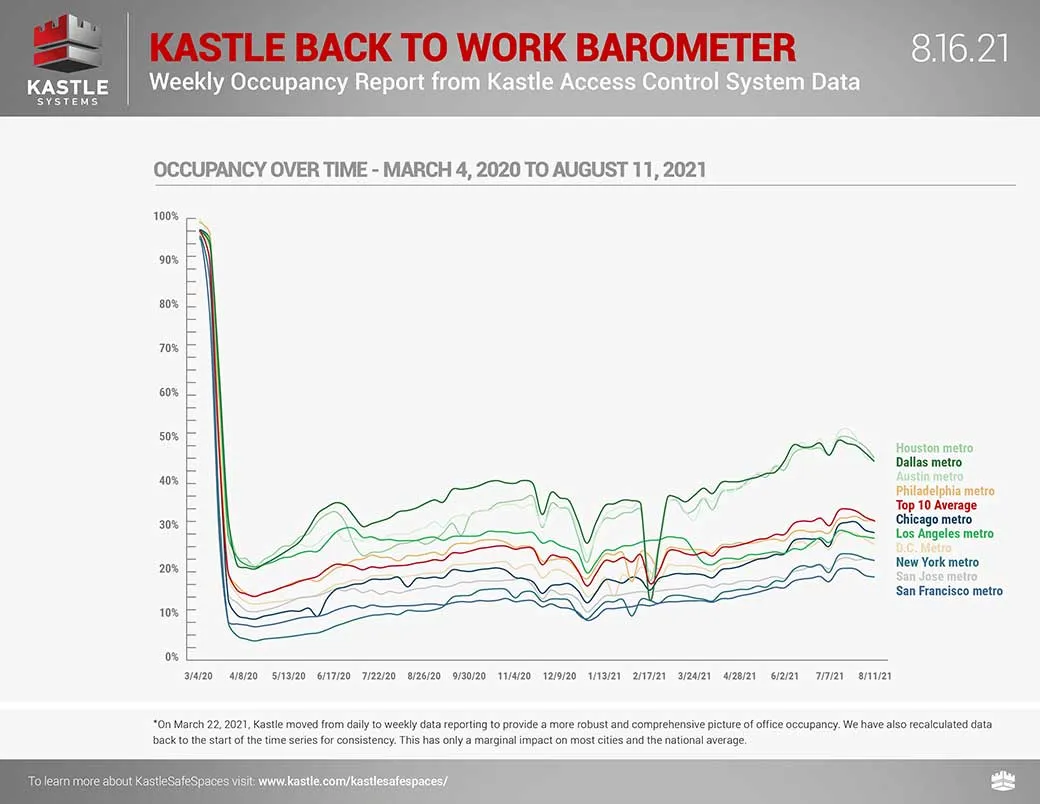Are we truly witnessing a transition?
Over the last few months, we discussed this idea that there is a "new normal" when it comes to work. Employees are resisting going back to the office and many companies are accommodating this.
Kastle Systems did some research to delve into what is going on in major cities. From a commercial real estate perspective, it is not too promising.
As we can see from this chart, the overall percentages are still way down from March of 2020.

Is this a new trend or just a short-term situation?
Human Conditioning
Humans are interesting species. We seem to be very slow to change our behavior. It appears that when we are comfortable with something, we will keep it that way. Change is hard for us. Overall, this is not something that people embrace.
COVID-19 and the resulting lockdowns meant that change was forced upon people. The technology to operate remotely existed for more than a decade. However, companies refused to embrace, not wanting to change. Of course, corporations are made up of people.
When people do change, one issue is that they tend not to go back. This is repeatedly shown with technology. While it might be hard to get someone to embrace something new, once they do, they will not return to their old ways.
This is a situation we might see playing out with the remote work situation.
People are now accustomed to working-from-home. Over the past 17 or 18 months, they are now getting things completed without having to commute into the office, deal with the company politics, have the hassle of food, or having the personal oversight from nosy managers.
Also, many are finding they have the ability to better engage their families, something that could not be done when they were gone 9 or 10 hours a day (or more).
Naturally, not everyone is keen on this idea, yet it does seem to be a significant percentage. Thus, we can see that this is not something that is going to reverse anytime soon.
Bad News For Urban Real Estate.
The first thing to be affected is obviously commercial real estate. These numbers on the above chart are should be very scary to owners of building in those cities. Of course, while 10 were studied, it is probably taking place in every city in the United States. In fact, we might be seeing this situation happening (or going to happen) across the world.
What is being shown here is staggering. With employee rates at less than 50%, if this trend holds up, it means that companies could cut their physical office space in half. Think about the impact that would make.
How would a city deal with half the office space presently rented suddenly hitting the market as leases come due? What would that mean to landlords as the available space started to skyrocket? Obviously rents would plummet causing other issues such as with bonds.
Commercial properties are not the only ones to be affected. We are also going to see the residential real estate sector hit. This is going to unleash a massive shift in where people choose to live.
When this concept of working remotely takes hold, people are not going to converge on the urban areas with the same force they did the last few decades.
As noted in the globalization of real estate we are likely seeing the end of the artificial urban real estate bubble. These areas attracted a lot of people, thus driving up prices because they had a monopoly on the better paying jobs.
The numbers seem to tell us that this is filtering into employees psyche. Since many are accustomed to working from home, the question of whether it is worth the money to reside close to work is going to come up? People, thus far, use the opportunity to move a bit further out, usually into the suburbs.
National and International Movement
Eventually, this is likely to extend further out.
The fact that it is rather new is causing some cautious moves. Companies are threatening to pull people back into the office. Nobody is really sure how much of the employment pool is forever "out of the office". We will have to see how things go the next 12-18 months.
Nevertheless, we can see from the statistics that, a year and a half in, most employees still are not back in the office. If most of them prefer this mode of operation, which it stands to reason the majority do, that is a large segment of the workforce not willing to enlist for the daily commute and everything else that goes along with office life.
Once this concept fully takes hold and employers start to adjust their requirements, especially for new hires, then we will start to see national movement. People will not move further out into the suburbs but, rather relocate to entirely new states. We are likely to see increased competition cropping up from different areas trying to lure people in.
At the same time, this will start the process of people looking internationally. If higher priced countries are less desirable, those that aggressively pursue those individuals can attract not only new residents, but investment also.
This completely changes a great deal of what is going to take place in terms of international migration.
Naturally, this is not going to happen overnight. We are still in the phase of where everyone is trying to determine how permanent this is. It looks like that we are far enough in that a percentage of employees will never return to the office. Companies are simply going to start catering to these people in an effort to either retain them or attract newer ones.
Either way, it does not look like that chart will ever reach 100% again.
If you found this article informative, please give an upvote and rehive.

gif by @doze

logo by @st8z